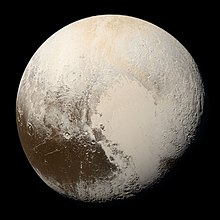Solar System/Pluto
Pluto was the first trans-Neptunian object to be discovered, and is the second largest one currently known. Its diameter is 2320 km, making it just 0.67 times the size of Earth's moon. Pluto's rotational period is 6.39 Earth-days. If you stood on the surface of Pluto, you would weigh only 6% as much as you do on Earth.

A Belated Discovery
editPluto was discovered on February 18, 1930 by Clyde Tombaugh as a planet. However, in 2006, Pluto is no longer a planet and is classified as a dwarf planet.
Satellites
editThe known satellites of Pluto are Charon, Nix, Hydra, Kerberos and Styx. Charon (pronounced like either Sharon or Karen) has almost exactly half the diameter of Pluto, making the pair essentially a double dwarf planet. Charon is only 12,200 miles (19,640 km) distant from its planet.
Orbit
editPluto's orbit is both highly eccentric (that is, far from being circular) and highly tilted relative to the orbital plane of Earth. Its eccentricity is 0.2482 (with 0.00 being circular and 1.00 being infinitely eccentric). Its orbital plane is tilted 17.15° from that of Earth. Pluto orbits the Sun in 248.54 Earth-years, at a distance from the Sun that averages 39.53 AU but ranges from 29.65 AU to 50.30 AU (where one AU—astronomical unit—is one Earth distance from the Sun). Thus Pluto spends part of its orbit closer to the Sun than the outermost planet, Neptune (which is always at least 29.80 AU from the Sun), although the two never come at all close to each other.
Gallery
edit-
Haze of the atmosphere of Pluto.
-
Closeup of Pluto
-
Ice at Sputnik Planum.
-
Water Ice detected on Pluto.
-
Moons of Pluto
-
Pluto and Charon.
-
Charon